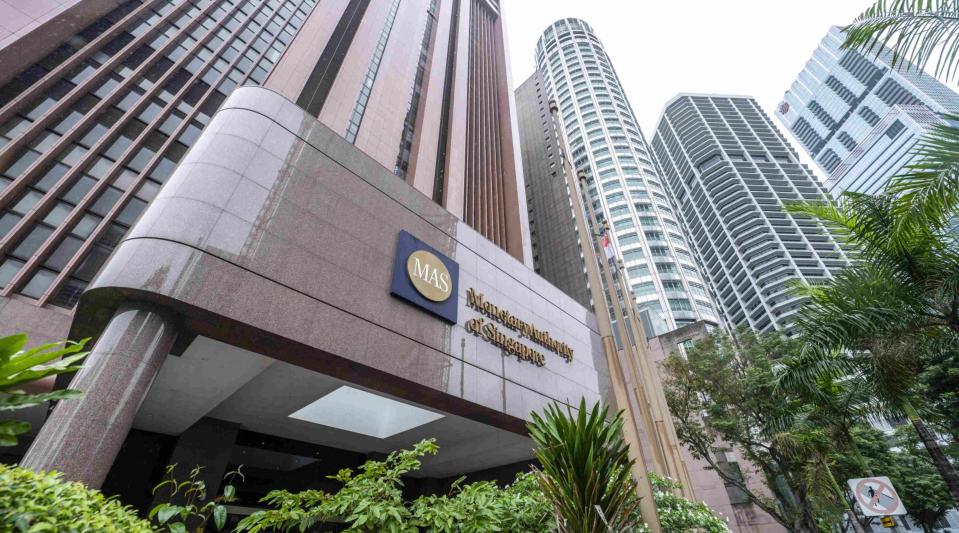MAS’s total emissions rise 14.3% y-o-y in FY2023/2024 with more business trips, but decarbonisation still ‘on track’

By FY2025/2026, MAS aims to cut Scope 1, Scope 2 and Scope 3 (business air travel) emissions by 17.5% from a FY2018/2019 baseline.
The Monetary Authority of Singapore’s (MAS) total carbon emissions rose 14.3% y-o-y in absolute terms to 14,327 tonnes of carbon dioxide equivalent (tCO2e) in FY2023/2024 ended March 31.
The largest contributor to this increase came from business air travel, which rose 68% y-o-y to 3,711 tCO2e. This segment contributed a larger share of MAS’s total emissions for the year, at 26% compared to 18% in the prior financial year, just shy of the FY2018/2019 baseline years 27% proportion.
That said, the central bank and regulator’s total emissions in FY2023/2024 were 10.7% lower than the baseline, according to MAS’s FY2023/2024 sustainability report, released July 4.
MAS’s Scope 2 emissions — or emissions arising from its electricity use — grew 8.3% y-o-y in FY2023/2024, though its share of total emissions was 2 percentage points lower y-o-y, at 30%, owing to the increase in business air travel emissions.
MAS’s Scope 2 emissions were also 10.5% higher than its FY2018/2019 baseline.
MAS says it used more electricity in its data centre to meet “business needs”, as well as increasing AI and work transformation applications.
Its higher electricity consumption is also due to the “ageing” central air-conditioning system in Currency House, which “consumed more energy and additional office space required for our work”. MAS says it is retrofitting Currency House’s chilled water plant to improve energy efficiency. “We are also working to implement additional measures to meet our Scope 2 reduction target by FY2025.”
In the fourth edition of its annual sustainability report, MAS says it remains “on track” to achieving its decarbonisation targets.
By FY2025/2026, MAS aims to cut Scope 1, Scope 2 and Scope 3 (business air travel) emissions by 17.5% compared to its FY2018/2019 baseline.
By FY2030/2031, MAS aims to further reduce this figure to reach 30% below the baseline.
In the latest financial year, MAS’s Scope 1, Scope 2 and Scope 3 (business air travel) emissions stood at 8,094 tCO2e, 3.6% below the baseline.
MAS also has a target to cut Scope 3 (outsourced currency operations) emissions by 10% by FY2025/2026 and 20% by FY2030/2031 compared to the baseline.
This segment comprises activities such as outsourced currency production, processing and transportation.
In the latest financial year, MAS’s Scope 3 (outsourced currency operations) emissions stood at 5,874 tCO2e, 18.6% below the baseline.
MAS says it is similarly “on track” to meeting its targets for outsourced currency operations emissions, through ongoing initiatives such as encouraging e-payments and the use of fit notes for festive gifting.
MAS’S near-term targets for Scope 1, Scope 2 and Scope 3 emissions reduction are set based on the Science Based Targets initiative (SBTi) methodology, which were independently validated by KPMG in 2022.
MAS says its carbon footprint is primarily generated by three major components: electricity consumption (Scope 2 emissions), business air travel (Scope 3 emissions) and outsourced currency operations (Scope 3 emissions). Together, these accounted or close to 97% of its total emissions in FY2023/2024.
Electricity, water and waste
MAS also reports its energy utilisation, water efficiency and waste disposal, in accordance with GreenGov.SG's metrics and targets.
MAS targets a 10% reduction in the Energy Utilisation Index (EUI) by 2030, compared to average of FY2018-2020 levels as the baseline. The EUI is the annual energy consumption divided by the total gross floor area.
In FY2023/2024, this figure was 155.1 kWh/sq m, 4.4% higher y-o-y. This was 7.5% above the baseline.
MAS also targets a 10% reduction in the Water Efficiency Index (WEI) by 2030, compared to average of FY2018-2020 levels as a baseline. The WEI is the annual water consumption per day divided by the total number of occupants, including visitors.
In FY2023/2024, this figure was 87.4, 19.4% lower y-o-y. This was just 3.4% above the baseline.
MAS attributes the decrease to measures such as deferred washing of building facade and installing Water Efficiency Labelling-rated sanitary fittings.
Finally, MAS also targets a 30% reduction in the Waste Disposal Index (WDI) by 2030, compared to FY2022/2023 baseline. The WDI is the total amount of waste disposed per day divided by the total number of occupants, including visitors.
In FY2023/2024, this figure was 0.32, 13.7% lower than the baseline. The measure of general waste disposed was obtained from SembWaste.
See Also:
Click here to stay updated with the Latest Business & Investment News in Singapore
What’s behind CDL’s ‘first-of-its-kind’ $400 mil sustainability-linked loan?
MAS reports lower emissions from its developed market equities, corporate bonds portfolio
Sustainability reporting ‘not a trivial exercise’: EnterpriseSG chairman
Get in-depth insights from our expert contributors, and dive into financial and economic trends

 Yahoo Finance
Yahoo Finance 